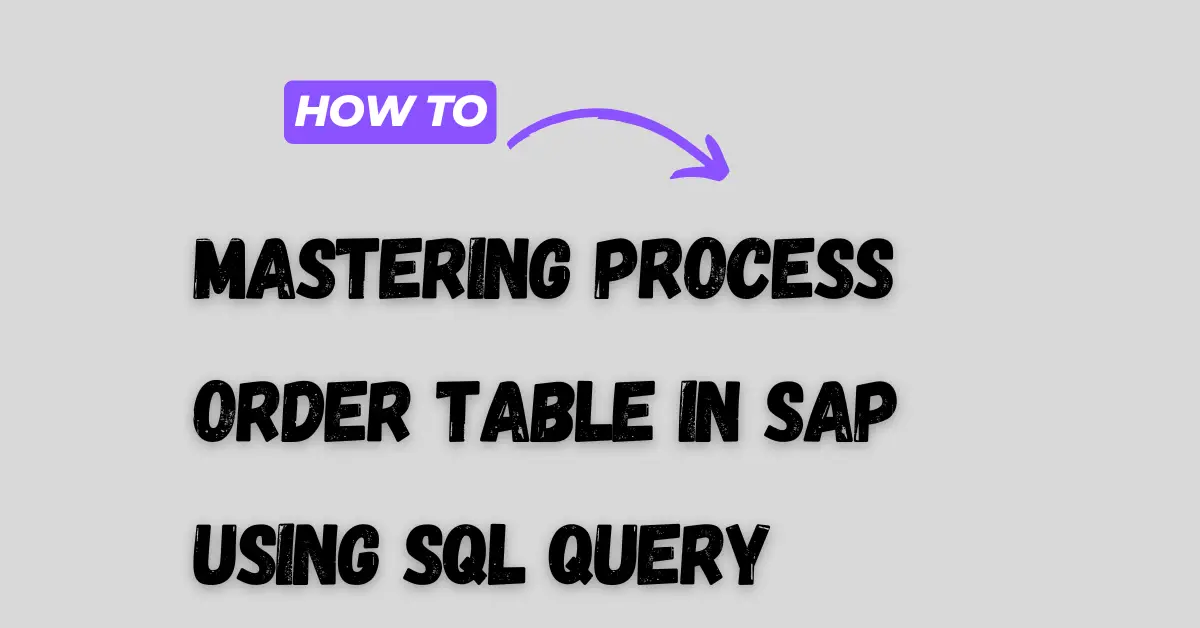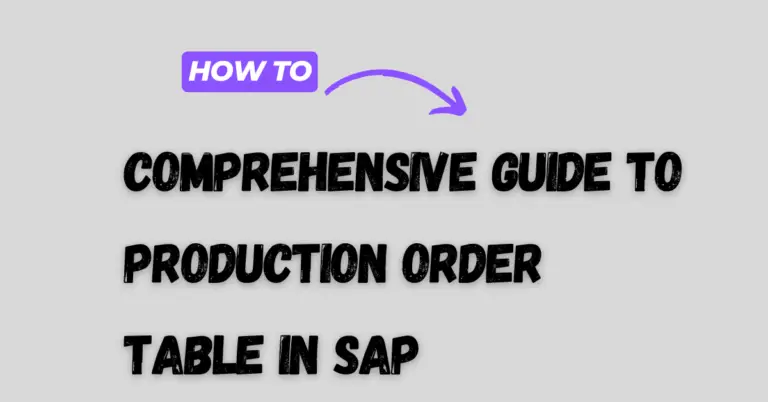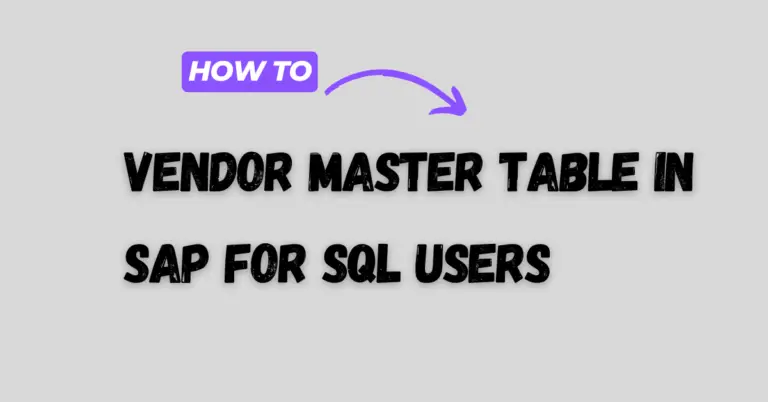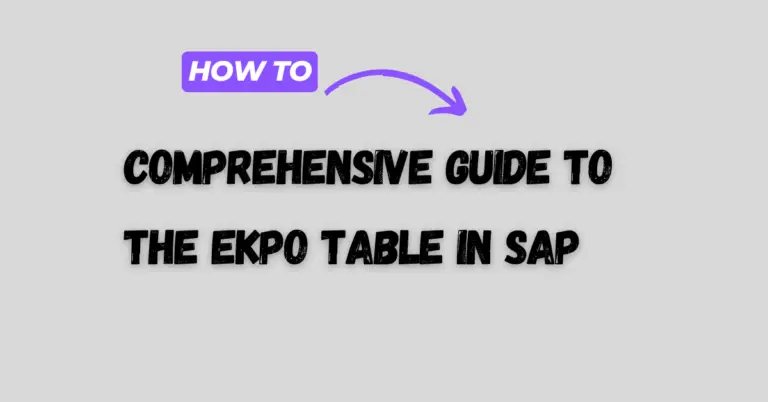Mastering Process Order Table in SAP using SQL Query
Process order table in SAP play a crucial role in manufacturing, particularly in industries requiring precise control over production processes, like chemicals, pharmaceuticals, and food processing. If you’re new to SAP and working on the backend to extract data using SQL queries, this guide will break down key process order tables, essential transaction codes (TCodes), and practical SQL tips to help you get started efficiently.

What is a Process Order table in SAP?
In SAP, a process order is a detailed document guiding the manufacturing of a product. It includes information on materials, production quantities, costs, and resources required to complete a production process. This structured record enables seamless planning, execution, and monitoring of production activities.
Key Process Order Tables in SAP
Understanding the purpose of each SAP table linked to process orders can help you navigate data extraction tasks with SQL queries. Here’s a breakdown of the primary tables associated with process orders, each with specific data that serves different stages of production.
1. Process Order Header Table: AFKO
The Process Order Header Table (AFKO) contains high-level data, such as the order number, order type, and creation date. This table is a good starting point if you need general information about each process order.
- Key Fields:
AUFNR(Order Number)AUART(Order Type)ERDAT(Creation Date)
Example SQL Query:
SELECT AUFNR, AUART, ERDAT
FROM AFKO
WHERE AUART = 'PP01';
This query retrieves order numbers, order types, and creation dates for all orders of type ‘PP01’ (Production Order).
2. Process Order Item Table: AFPO
The Process Order Item Table (AFPO) contains details about each item (or component) linked to a process order. Information such as material numbers, required quantities, and delivery dates is stored here, making this table essential for tracking the components of each order.
- Key Fields:
AUFNR(Order Number)MATNR(Material Number)PSMNG(Planned Quantity)
Example SQL Query:
SELECT AUFNR, MATNR, PSMNG
FROM AFPO
WHERE MATNR = '12345';
This query fetches order numbers and planned quantities for a specific material.
SAP Production Planning Tables for Backend Data Retrieval
3. Process Order Material List Table: RESB
The Process Order Material List Table (RESB) stores information about materials reserved for each process order, such as reserved quantity and storage location. This is valuable for material planning and tracking.
- Key Fields:
RSNUM(Reservation Number)MATNR(Material Number)LGORT(Storage Location)
Example SQL Query:
SELECT RSNUM, MATNR, BDTER, LGORT
FROM RESB
WHERE AUFNR = '100000001';
This query retrieves the reservation number, material details, and storage location for a specific order number.
4. Process Order Status Table: JEST
The Process Order Status Table (JEST) is useful for tracking each process order’s status, whether it’s created, released, or completed. With the status information, you can get insights into the progress and current state of production orders.
- Key Fields:
OBJNR(Object Number)STAT(System Status)INACT(Inactive Indicator)
Example SQL Query:
SELECT OBJNR, STAT
FROM JEST
WHERE OBJNR = 'ORDER_OBJECT' AND INACT = '0';
This query fetches active statuses for a specific order, using the object number.
5. Process Order Confirmation Table: AFRU
The Process Order Confirmation Table (AFRU) logs confirmations for each process order, including data on actual production quantities, time taken, and labor hours. This table is essential for tracking progress and performance.
- Key Fields:
RUECK(Confirmation Number)AUFNR(Order Number)ISMNG(Yield)
Example SQL Query:
SELECT RUECK, AUFNR, ISMNG
FROM AFRU
WHERE AUFNR = '100000002';
This query displays confirmation numbers and yields for a particular process order.
6. Planned Order Table: PLAF
Planned orders are preliminary orders that become process orders once confirmed. The Planned Order Table (PLAF) contains planned orders in the SAP system before they are converted, making it useful for forecasting production needs.
- Key Fields:
PLNUM(Planned Order Number)MATNR(Material Number)GSTRP(Planned Start Date)
Example SQL Query:
sqlCopy codeSELECT PLNUM, MATNR, GSTRP
FROM PLAF
WHERE MATNR = '98765';
This query pulls planned order data, including start dates, for a particular material.
Essential TCodes for Process Orders in SAP
For each step in the process order lifecycle, SAP provides transaction codes (TCodes) that simplify data entry and management:
- COR1: Create Process Order – used to initiate process orders by defining relevant order data and materials.
- COR3: Display Process Order – allows you to display details of an existing process order.
- CO11N: Confirm Process Order – enables you to confirm order completion, entering the final production data.
Using these TCcodes can enhance your workflow, allowing you to manage and interact with process orders directly.
Querying Process Order Data with SQL: Practical Tips
When working on the backend to extract data, a few SQL best practices can make your data retrieval more efficient:
- Use Joins for Comprehensive Reports:
To combine data across multiple tables, useJOINstatements. For instance, joiningAFKO,AFPO, andRESBcan give you a consolidated view of order headers, items, and materials.
SELECT A.AUFNR, A.AUART, B.MATNR, C.LGORT
FROM AFKO A
JOIN AFPO B ON A.AUFNR = B.AUFNR
JOIN RESB C ON A.AUFNR = C.AUFNR
WHERE A.AUART = 'PP01';
- Filter Data with WHERE Clauses:
Always applyWHEREclauses to limit large datasets based on specific conditions, such as order type or material number, which can significantly reduce query runtime. - Practice Using Indexes:
Fields likeAUFNR(Order Number) andMATNR(Material Number) are often indexed, which can boost query performance. Knowing these indexed fields helps in constructing faster, more efficient queries.
Conclusion
Process orders are integral to production planning and execution in SAP, and understanding the right tables and TCcodes is key for backend data management. By mastering tables such as AFKO, AFPO, and RESB and using SQL to fetch essential data, you can generate reports and insights that support effective decision-making in manufacturing.
For those new to SAP, start with simple queries and gradually incorporate joins and filtering techniques. With time, you’ll become proficient in managing SAP data and providing valuable information to your team.
Learn about Production Order Table in SAP





